The Wii palette was obviously a suboptimal choice, it’s the “PAL” one, afaik the only one not with an NTSC origin. Don’t know what the story behind it is, the process behind palettes is often useful to know.
That FCE palette on the PS2 also very much benefits from TV adjustments though, especially for NTSC with my other TVs.
I’m going to do some other tests with the 2006 set in the next days.
Anyway here’s something related concerning the possible effects of filtering when dealing with a non-standard signal. Great Hierophant had a writeup on his blog concerning the Apple II, which I recommend to read in full of course.
But here’s the part with illustrations I found most interesting:
"The notch filter was about as sophisticated a filtering method as encountered in most composite color computer monitors and TV sets up to the late 1980s. The Apple ColorMonitor IIe a.k.a the AppleColor Composite Monitor IIe and the AppleColor Composite Monitor IIc as well as the Commodore 1084s use notch filters.
The next innovation in luma/chroma composite signal separation was the delay line. With the two line delay system, the monitor would store one line of a signal, extract the luma and chroma from it while the next line was being sent. Because two vertically adjacent lines tend not to have wildly varying colors, when the mostly inverted phases of the color carriers of the two lines are combined they will reduce or cancel each other out leaving much less affected luma than by just using a notch filter.
The two-line delay system was an improvement but it was not perfect and some systems improved on it a little by using a three-line delay system. High frequency horizontal color detail can bleed into the luma channel, leading to “dot crawl”. Additionally, sharp changes in luma can lead to rainbow artifacts and color bleed. To reduce these unsightly artifacts, a more sophisticated adaptive two-dimensional (2D) three line adaptive system was invented to vary the color comparisons over three lines as they were being drawn to best reduce dot crawl. Finally, three-dimensional (3D) motion adaptive comb filters compare the lines of the previous frame with that of the current frame to virtually eliminate dot crawl.
Comb filters work by assuming the signal follows the NTSC rules. Of course, the Apple II signal does not follow the NTSC rules in several respects. First, the Apple II video signal is progressive rather than interlaced. Second, the Apple II does not invert the phase of every other line, the phase starts at the same point in time on every line. This tends to make comb filters behave a little strangely on the Apple II. Because comb filters have to combine the color signal of every pair of lines, they tend to cause a loss of vertical detail. In the Apple II, this detail can result in the blending of alternating single color lines.
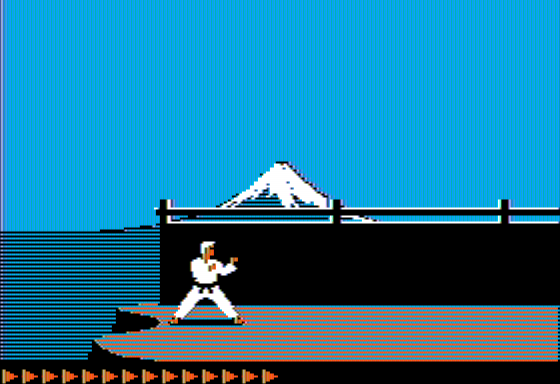 Karateka with Notch Filter
Karateka with Notch Filter
Consider this screenshot of Karateka. The ground is being drawn, in canonical Apple II colors, as alternating blue and orange colors. The black and white image (quite commonly seen on the green screens of the day) shows a checkerboard pattern.
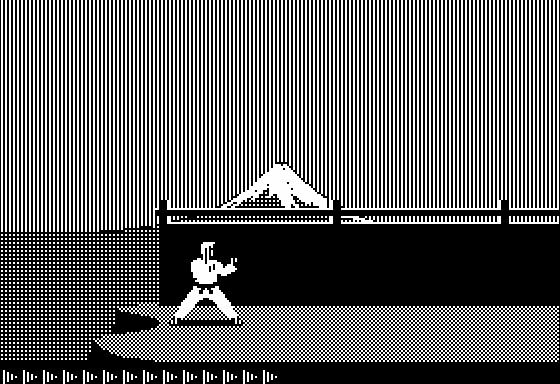 Karateka in Monochrome (raw pixel)
Karateka in Monochrome (raw pixel)
Now consider the pattern through a typical two-line comb filter :
 Karateka with Delay Line Comb Filter
Karateka with Delay Line Comb Filter
As you can see, the lines have been blended together to show a gray which would not ordinarily register to the eye as gray. Perhaps the crappiest vintage color TVs may blend these lines together to make a solid gray, but that TV would make for a crappy computer monitor. As blue and orange rely on pixels which are vertically adjacent to each other by one pixel, when you combine them you could get a white signal but due to luma being off over 50% of the line, you get gray instead. The same thing would happen for alternating green and purple lines. However, you can get different colors by mixing colors which are not 90 degrees out of phase with each other.
Finally, let’s consider how a 3D adaptive motion comb filter would handle this image :
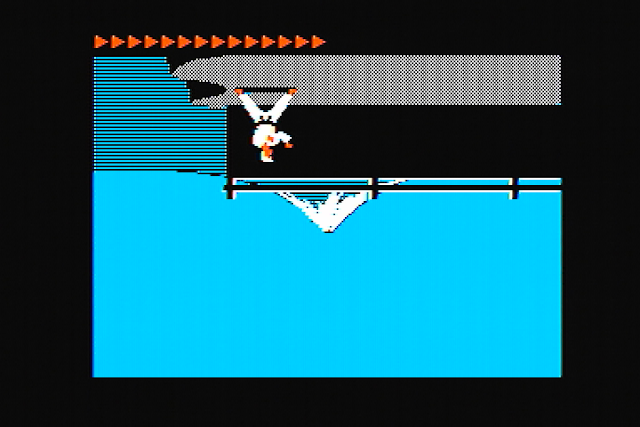 Karateka (Side B) with 3D Motion Adaptive Comb Filter
Karateka (Side B) with 3D Motion Adaptive Comb Filter
As you might note, the sophisticated comb filter has done its job too well here, eliminating virtually all the color, which it sees in this instance as a rainbow artifact to be canceled out. In fact, we have come full circle to reproduce, as well as a capture card can, the original dots making up the video signal! The lack of evenly sized pixels and the resulting scaling artifacts is a symptom of composite/s-video capture cards which only sample composite video at 13.5MHz. As the pixel clock is 7.19MHz, you would need a sample rate of 14.318MHz to fully capture all the pixels without scaling artifacts.
If you look at the back of the box in which Karateka was sold, you should see a gray color to the ground, suggesting that comb filtering was not unknown in the 1980s. But this is not the only example of probable reliance on comb filtering. Consider the title screen to the Bard’s Tale :
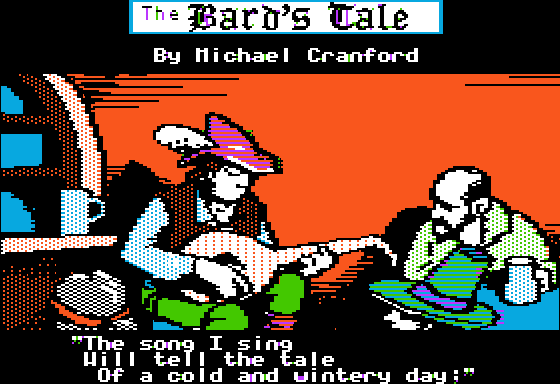 As you see, the hat of the bard and and of one of the listeners has alternating bands of color, orange/purple, green/blue and purple/blue. But consider how a comb filter blends these color bands :
As you see, the hat of the bard and and of one of the listeners has alternating bands of color, orange/purple, green/blue and purple/blue. But consider how a comb filter blends these color bands :
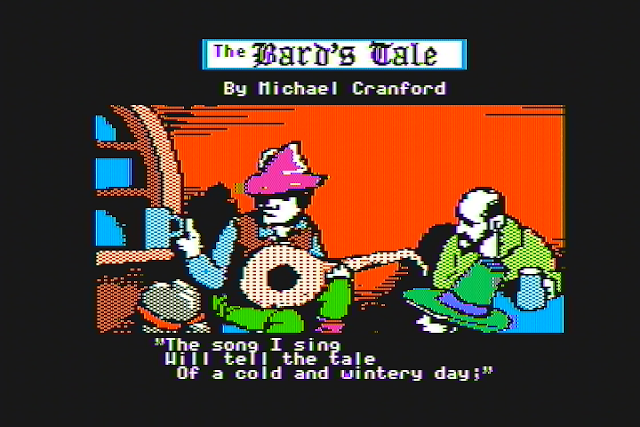 The Bard’s Tale - Delay Line Comb Filter
The Bard’s Tale - Delay Line Comb Filter
Now the Bard’s hat is a solid color pink and the listener’s hat has a green color that is different from the normal green (see the Bard’s pants) and a purplish-blue-ribbon that is not the normal purple or blue hue. If you used a display with a motion adaptive 3D comb filter, you would see dots instead of lines or solid color, something that is definitely not ideal.
"
From the comments re: that upside down Karateka pic:
“It is not a mistake. It displays upside down relative to the normal way the game is played, but if you look closely, the elements are not mirrored as they should be if I had flipped the image 180 degrees…”

 ; bought a retrobit Saturn cable)
; bought a retrobit Saturn cable)








 Unlike the Wii, PAL-consoles output NTSC in 60Hz mode. But the TV can’t handle NTSC
Unlike the Wii, PAL-consoles output NTSC in 60Hz mode. But the TV can’t handle NTSC 






























